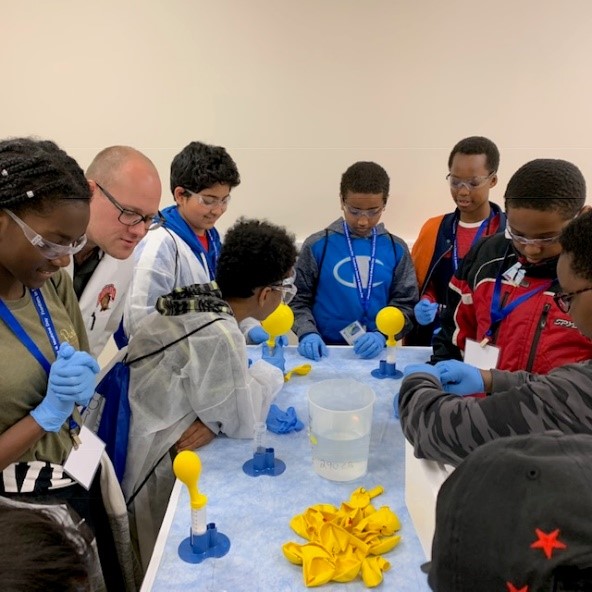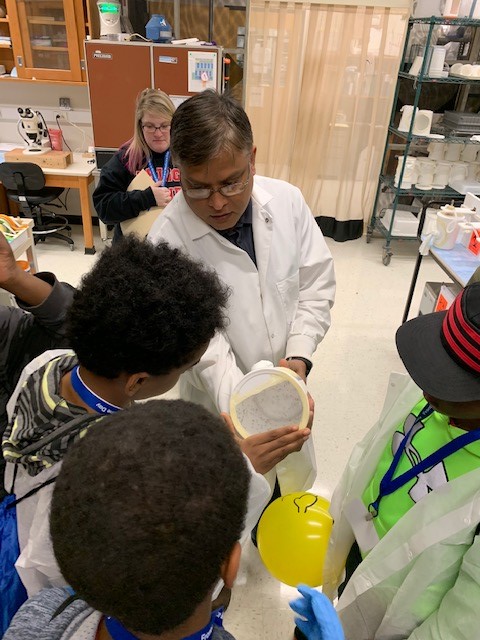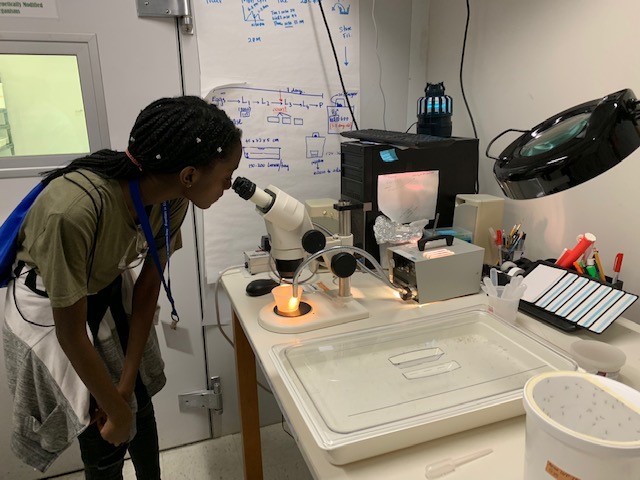IBBR welcomes middle school students for Frontiers in Science & Medicine Day

November 16, 2018 -- Thirty-seven bright, inquisitive seventh graders from Briggs Chaney and Banneker Middle Schools of Montgomery County visited IBBR on Friday, November 9 for an especially eye-opening and mind-expanding school day. The Frontiers in Science and Medicine Day program, a collaborative effort among organizations within the Shady Grove Life Sciences Center, is celebrating its tenth year with nearly 600 students participating program-wide. IBBR has hosted groups of students for nine years of the Frontiers program.
In the impressionable, formative years when middle school students are beginning to think about what they want to be when they grow up, Frontiers immerses them in real-world science for a day in a way that complements the classroom setting. Students tour laboratory facilities, observe scientists at work, and complete hands-on activities at local science and technology companies, medical centers, college campuses, and scientific/translational institutes. The program hopes to motivate students to consider pursuing higher education and careers in science, medicine, and technology.
This year, students toured IBBR’s Insect Transformation Facility, where they observed the various life stages of mosquitoes and black soldier flies, heard why  scientist s want to understand the mechanisms involved in disease transmission in medically or agriculturally important insects, and learned how genetically modified organisms (GMOs) enable scientists to study gene function.
scientist s want to understand the mechanisms involved in disease transmission in medically or agriculturally important insects, and learned how genetically modified organisms (GMOs) enable scientists to study gene function.
Through a computerized matching game, they explored 3D protein structures. IBBR scientists explained the tools they use to determine those structures, and the students learned how that information can be used in pharmaceutical development.
Students also visited the Institute’s Plant Growth Facility and met with scientists from KeyGene USA, a crop innovation company co-located at IBBR specializing in crop improvement by molecular breeding. The scientists taught the students about the use of controlled environments and the importance of the different capabilities of the facility, such as photoperiod lighting, thermal barriers, watering and fertilizing to grow plants for research. They also learned about ways that plant scientists use innovative technology to develop new natural resources, such as natural rubber from dandelion roots.
In a hands-on activity to explain phase changes (liquid, solid, gas), each student squirted water into a tube filled with dry ice, stretched a balloon over the tube, and watched as CO2 gas bubbles rose through the water and filled the balloon.
 Dr. Jennifer Tullman, an IBBR researcher from the National Institute of Standards and Technology (NIST), was inoculating E. coli cultures for protein expression when the students came through her lab. “They especially enjoyed watching me use the Bunsen burner, a very common piece of laboratory equipment that some of them had not seen before. As we toured the greenhouse, many of them also learned about stevia for the first time. They were like sponges, soaking up information and their curiosity about everything in the labs was apparent,” said Tullman.
Dr. Jennifer Tullman, an IBBR researcher from the National Institute of Standards and Technology (NIST), was inoculating E. coli cultures for protein expression when the students came through her lab. “They especially enjoyed watching me use the Bunsen burner, a very common piece of laboratory equipment that some of them had not seen before. As we toured the greenhouse, many of them also learned about stevia for the first time. They were like sponges, soaking up information and their curiosity about everything in the labs was apparent,” said Tullman.
“IBBR is a perfect fit for the Frontiers program,” said Dr. Thomas Fuerst, IBBR Director. “With the ongoing emphasis on STEM education, we value the opportunity to participate in the Frontiers program and to provide these young students an opportunity to see scientists at work in a cutting-edge research facility. We hope that some of them will be inspired to be future doctors, scientists, and engineers.”
-----
Inquiries: communications@ibbr.umd.edu
